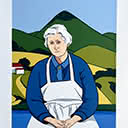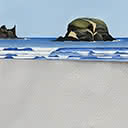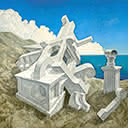Allan's Beach
28 x 22 cm
est. $25,000 - 35,000
Windswept but beautiful Allan's Beach is almost a kilometre in length and is named after a European farming family who were settlers in the district in the 1870s. It is only six kilometres from where Robin White lived at Lower Portobello and would have been in easy reach for short sketching excursions. It is characterised by its wide expanse of white sand which feels like icing sugar under foot. It is on the southeast facing seaward side of the long spit which narrows the entrance to Hooper's Inlet to a channel just 170 metres wide. Surfers, trampers, artists (and naturists) reach this spot by walking an easy 500 metres across farmland and through a system of dunes which are covered in pīkao (pingao) sedge. The hollows in the sand often conceal slumbering fur seals, and sea lions as well as the nests of endangered yelloweyed penguins. An abundance of shore and seabirds fill the skies, and the colour of the water ranges from a deep green to crystal clear turquoise to a pale royal blue as it is in this painting.
Robin White's watercolour and acrylic captures the beach on a calm and cloudless autumn day in April 1975, with the waves folding in an orderly fashion like curling pieces of parchment. The centrepiece of the work is the rounded form of Wharekakahu, the 40-metre-high island just immediately offshore from the Belmont promontory which is visible on the left and forms part of the eastern end of the beach. Known for its colony of Stewart Island shags usually visible near the right-hand end of its crest, Wharekakahu also has a colony of green-backed skinks and is a predator-free reserve, its Maori name alluding to the cloak of green vegetation covering its form. Based on a pencil drawing she made of the scene which was exhibited alongside this painting, Robin White has characterised Allan's Beach as deserted.
The isolation and pristine nature of this coastline is emphasised by the tipped-up expanse of beige sand in the foreground. When she made this work, Robin White had been living in Dunedin for just over two years, having decamped from Bottle Creek and Porirua and driven south in December 1971. Gallerist Maureen Hitchings had driven her around the Otago Peninsula and she fell in love with the locality. A year later in 1972, she was married. 1973 was meant to be her first year as a full-time artist, but her work was interrupted by the arrival of her son Michael, born in the spring. She still managed to participate in the Paris Print Biennale and exhibit with the Print Council of New York. Two years later, in 1975, she drew and painted Michael sitting on her studio floor holding one wing of his Buzzy Bee. Transposing this image to Allan's Beach, she put a tangle of kelp behind him and a dead seagull in front of him, framing the composition like an inverted tombstone. She exhibited this drawing and watercolour as Michael, Allan's Beach. Many years later, she commented that the dead bird was a cipher for what she felt might be the loss of her soaring career with the onslaught of motherhood. Despite her fears, her artistic successes continued. In February 1975, Harry Miller applauded her success in receiving Queen Elizabeth II Arts Council grant in his column in Dunedin's Evening Star and the Auckland Art Gallery organised an outreach exhibition of her paintings and prints in the Avondale Branch Library. She put the money towards a new studio in which she produced exhibitions of pencil, watercolour and silkscreen prints for both Peter McLeavey Gallery in Wellington (December 1975), and Barry Lett Galleries in Auckland. It was at the latter exhibition that this painting was purchased by Patrick Hutchings for $500 in August 1976.
Essay by - Linda Tyler





